Sarah Sundin's Blog, page 533
February 4, 2011
Ever feel like a loser? Like your bad habits have you in...
 Ever feel like a loser? Like your bad habits have you in a stranglehold? Like your past gets in the way of your future?
Ever feel like a loser? Like your bad habits have you in a stranglehold? Like your past gets in the way of your future?Consider Samson. In Hebrews 11:32, he's numbered among the heroes of faith. His life contained acts of God-given physical strength to protect the Israelites from the Philistines. But his life was also a sordid drama of anger, lust, and weakness of will.
What sealed his place in the rank of biblical heroes was his death. Blinded, enslaved, humiliated, he prayed for one last burst of strength and received it. "He killed many more when he died than while he lived" (Judges 16:30).
We can learn a lot from Samson's example.
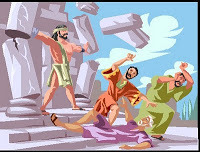
1) God can forgive any sin
Samson's acts of immorality loom large, especially his flippant attitude toward God's gift and the vows required to keep it. Yet in Samson's final moments, he was forgiven. Our sins can never outweigh God's forgiveness.
2) God can use the forgiven sinner
Samson's history did not make him useless to the Lord. When he prayed for strength, he received it, and God used him for one last mighty act. And see how the Lord redeemed his sin—his defeat placed him between those pillars right where God could use him. The Lord can use us too, no matter where our sin has placed us.
3) Even forgiven sin has consequences
Samson repented, but he bore the consequences of his sin—he did not regain his sight or freedom—and he died. We mustn't ever take sin lightly.
What do you take from Samson's example?
Published on February 04, 2011 05:00
Today in World War II History
70 Years Ago—Feb. 4, 1941: Happy 70th birthday, USO! United Service Organizations established to provide social clubs and entertainment for troops.
Published on February 04, 2011 03:00
February 3, 2011
Today in World War II History
70 Years Ago—Feb. 3, 1941: German battlecruisers Scharnhorst and Gneisenau start raids on British shipping in the North Atlantic, will sink 22 ships by March 22.
Published on February 03, 2011 03:00
February 2, 2011
You're Invited!
 You're Invited! How does an author go about writing a book? What goes into researching a historical novel? Will there be refreshments? Tuesday February 8, 2011, I'll be speaking at the Antioch Public Library in Antioch, California from 6:30-7:30 pm. I'll be discussing the process of writing a novel and how I researched the Wings of Glory series - A Distant Melody (2010), A Memory Between Us (2010), and Blue Skies Tomorrow (August 2011). Since each of the novels is partially set in Antioch, California during World War II, I'll be sharing some fun tidbits I learned about wartime Antioch. Most importantly...yes, there will be refreshments! Here's the link to the event on the library website: http://nt-evanced.ccclib.org/evanced/lib/eventsignup.asp?ID=28324&return=http%3A%2F%2Fnt%2Devanced%2Eccclib%2Eorg%2Fevanced%2Flib%2Feventcalendar%2Easp Please contact me with any questions. I would love to see you there!
You're Invited! How does an author go about writing a book? What goes into researching a historical novel? Will there be refreshments? Tuesday February 8, 2011, I'll be speaking at the Antioch Public Library in Antioch, California from 6:30-7:30 pm. I'll be discussing the process of writing a novel and how I researched the Wings of Glory series - A Distant Melody (2010), A Memory Between Us (2010), and Blue Skies Tomorrow (August 2011). Since each of the novels is partially set in Antioch, California during World War II, I'll be sharing some fun tidbits I learned about wartime Antioch. Most importantly...yes, there will be refreshments! Here's the link to the event on the library website: http://nt-evanced.ccclib.org/evanced/lib/eventsignup.asp?ID=28324&return=http%3A%2F%2Fnt%2Devanced%2Eccclib%2Eorg%2Fevanced%2Flib%2Feventcalendar%2Easp Please contact me with any questions. I would love to see you there!
Published on February 02, 2011 05:00
February 1, 2011
Today in World War II History
70 Years Ago—Feb. 1, 1941: German heavy cruiser Admiral Hipper leaves Brest, France to raid British shipping in the North Atlantic for the next four months. US Navy forms Atlantic Fleet, Asiatic Fleet, and Pacific Fleet.
Published on February 01, 2011 03:00
January 31, 2011
Make It Do - Sugar Rationing in World War II
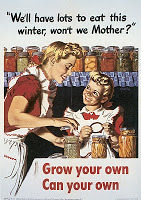 What could be more American than Hershey bars, homemade cookies, and birthday cake? During World War II these items were hard to come by.
What could be more American than Hershey bars, homemade cookies, and birthday cake? During World War II these items were hard to come by.Short on Sugar
When the Japanese conquered the Philippines in the early months of 1942, the United States lost a major source of sugar imports. In addition, shipments from Hawaii had to be curtailed 50 percent as cargo vessels were diverted for military purposes. The supply fell by one-third. To ensure adequate supplies for manufacturers, the military, and civilians, sugar became the first food item to be rationed. Manufacturers initially received supplies at 80 percent of pre-war levels, but that was reduced over time. Registration for Rationing On April 27, 1942, families registered for ration books at their local elementary schools. One book was issued for each family member and had to be surrendered upon death. The sale of sugar was halted for one week to prepare for the program. To discourage hoarding, each family had to report how much sugar they had in stock - over a certain amount - and the corresponding number of stamps was removed from the book. Ration Books
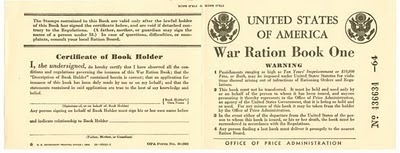 On May 5, 1942, each person in the United States received a copy of War Ration Book One, good for a 56-week supply of sugar. Initially, each stamp was good for one pound of sugar and could be used over a specified two-week period. Later on, as other items such as coffee and shoes were rationed, each stamp became good for two pounds of sugar over a four-week period. The ration book bore the recipient's name and could only be used by household members. Stamps had to be torn off in the presence of the grocer. If the book was lost, stolen, or destroyed, an application had to be submitted to the Ration Board for a new copy. When entering the hospital for greater than ten days, the ration book had to be brought along.
On May 5, 1942, each person in the United States received a copy of War Ration Book One, good for a 56-week supply of sugar. Initially, each stamp was good for one pound of sugar and could be used over a specified two-week period. Later on, as other items such as coffee and shoes were rationed, each stamp became good for two pounds of sugar over a four-week period. The ration book bore the recipient's name and could only be used by household members. Stamps had to be torn off in the presence of the grocer. If the book was lost, stolen, or destroyed, an application had to be submitted to the Ration Board for a new copy. When entering the hospital for greater than ten days, the ration book had to be brought along.
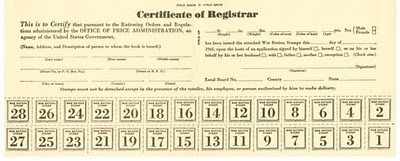 Canning Home canning was encouraged during the war - however, canning requires sugar. To provide for this patriotic need, each person could apply for a 25-pound allotment of canning sugar each year. Each local ration board determined the quantity and season of availability based on the local harvest. A special canning sugar stamp in the ration book had to be attached to the application. In 1944, confusion arose when "spare canning sugar stamp 37" was called for - but many people mistakenly used the regular sugar stamp 37, invalidating it for normal household purchases. Shortages Just because you had a sugar stamp didn't mean sugar was available for purchase. Shortages occurred often during the war, and in early 1945 became acute. As Europe was liberated from Nazi Germany, the US took on the main responsibility for providing food to those ravaged countries. On May 1, 1945, the sugar ration was cut to 15 pounds per year for household use and 15 pounds per year for canning - a total of eight ounces per week. Sugar was the last product to be rationed after the war. The program was discontinued in June 1947. Housewives learned to be creative, using saccharine, corn syrup, and even packets of Jell-O as sugar substitutes. Women's magazines featured recipes with reduced sugar or creative substitutes. Do you have any stories of wartime sugar rationing?
Canning Home canning was encouraged during the war - however, canning requires sugar. To provide for this patriotic need, each person could apply for a 25-pound allotment of canning sugar each year. Each local ration board determined the quantity and season of availability based on the local harvest. A special canning sugar stamp in the ration book had to be attached to the application. In 1944, confusion arose when "spare canning sugar stamp 37" was called for - but many people mistakenly used the regular sugar stamp 37, invalidating it for normal household purchases. Shortages Just because you had a sugar stamp didn't mean sugar was available for purchase. Shortages occurred often during the war, and in early 1945 became acute. As Europe was liberated from Nazi Germany, the US took on the main responsibility for providing food to those ravaged countries. On May 1, 1945, the sugar ration was cut to 15 pounds per year for household use and 15 pounds per year for canning - a total of eight ounces per week. Sugar was the last product to be rationed after the war. The program was discontinued in June 1947. Housewives learned to be creative, using saccharine, corn syrup, and even packets of Jell-O as sugar substitutes. Women's magazines featured recipes with reduced sugar or creative substitutes. Do you have any stories of wartime sugar rationing?
Published on January 31, 2011 05:00
Today in World War II History
70 Years Ago—Jan. 31, 1941: Vichy French sign Japanese-negotiated armistice with Thailand.
Published on January 31, 2011 03:00
January 30, 2011
Today in World War II History
70 Years Ago—Jan. 30, 1941: Australians take Derna, Libya.
Published on January 30, 2011 03:00
January 29, 2011
Today in World War II History
70 Years Ago—Jan. 29, 1941: US and Britain begin joint discussions in Washington which will lead to ABC-1 Plan in case of America entering war against Germany. British forces from Kenya invade Italian Somaliland.
Published on January 29, 2011 03:00
January 28, 2011
How's Your Heart-Soil?
 We have a lot of dirt in our house. Both my daughter and my youngest son recently completed science experiments involving soil, water or nutrients, and plant growth.
We have a lot of dirt in our house. Both my daughter and my youngest son recently completed science experiments involving soil, water or nutrients, and plant growth.So dirt's on my mind.
In the parable of the sower, Jesus compared the condition of our hearts to soil types. The hard path represents the heart hardened to God's Word. The rocky soil represents a shallow heart unable to withstand trouble or persecution. The soil choked with weeds represents a heart distracted by worries and prosperity. And the fertile soil represents a heart that produces a fruitful life.
We want hearts that produce great works for God's Kingdom. However, just as farming is hard work, so is the Christian life.

Plow
Soil and hearts both need plowing to allow seed to settle deep enough to grow and to create paths for roots. Sometimes God plows our lives with trials and tough times that turn our life—our soil upside-down. We can also plow with prayer, asking the Lord to break up our hard parts, turning our lives over for examination, and letting His Holy Spirit aerate our hearts. The act of plowing is painful and sweaty—but worth it.
 Weed
WeedSoil and hearts need careful maintenance to remove rocks and weeds. "The worries of this life, the deceitfulness of wealth and the desire for other things" act just like weeds. By stealing our resources of time, energy, money, and focus, they inhibit our growth. They block the view of the Son and His empowering light. We need to be vigilant for weeds and brutal about removing them.
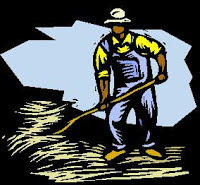
Fertilize
Soil and hearts also need proper fertilizing. For plants, the proper balance of water and nutrients leads to the greatest growth and highest yield. Likewise, our hearts need a constant and balanced diet of prayer and Bible study, fellowship and worship. Then we can yield the fruit of service and giving, ministry and outreach.
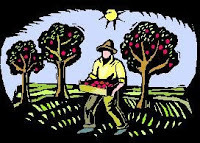
Harvest! "Like seed sown on good soil, hear the word, accept it, and produce a crop—thirty, sixty or even a hundred times what was sown" (Mark 4:20).
How can you take care of your heart-soil today?
Published on January 28, 2011 05:00



